
by Elizabeth S. Craig, @elizabethscraig
In every cozy mystery, there comes a time when the sleuth puts together various clues and realizes who the perpetrator is.
But the timing of this revelation can take the story on different paths.
Frequently, there’s a scene near the end of the book when the sleuth confronts or is confronted by the murderer. It’s the ‘moment of danger’ where it looks a little shaky for the sleuth. After all, this is someone who has already killed once (often twice) and is desperate to escape justice.
So when does the sleuth realize the murderer’s identity: before or during this dangerous encounter?
Before the confrontation
When the sleuth puts two and two together before she confronts the killer, it shows the reader that the gifted amateur is genuinely good at detecting. She’s dug up clues, analyzed them, and has come up with a solution to the puzzle that makes sense.
But…now this smart person heads out to challenge the murderer? Considering that the cozy sleuth isn’t a member of the police department, this seems very risky.
Possible ways of preventing the sleuth from doing something stupid:
The killer confronts the sleuth instead of the other way around (the bad guy/girl realizes that the sleuth is onto them).
The sleuth believes herself to be confronting the killer in a safe way (she’s supposed to have backup with her…and her backup had car trouble, forgot, etc.)
During the confrontation
Maybe sometimes the sleuth has duly registered the clues but hasn’t been able to really put it all together in a way that makes sense. Or maybe there’s a final clue during a normal conversation with the suspect…perhaps the sleuth realizes that the suspect has just negated their alibi or knows something about the crime that only the killer would know.
This solves the problem of the sleuth looking stupid or reckless for putting herself in danger. But if it’s not handled well, it can also make the sleuth appear to be slow to figure out the puzzle, especially if the reader has already figured it out (and mystery readers are a savvy bunch).
Possible ways of making sure the sleuth looks good through a last-minute realization:
Have an excellent red herring at the very end. Even better if it’s very subtle and both the sleuth and the reader feel that they’ve learned the killer’s identity. The sleuth could be investigating this lead when she happens into the encounter with the actual murderer.
Have the solution be on the very tip of the sleuth’s tongue. Hercule Poirot frequently mentioned in frustration that he knew something important that would identify the murderer, but he couldn’t place exactly what it was.
Additionally:
The sleuth usually explains how she figured out the murderer’s identity. This explanation could be provided to the police or given to a sidekick, or could even be explained to the killer himself during the confrontation scene.
What I’ve noticed that readers dislike is if the murderer gives a villainous monologue explaining how they carried out the murders. Better to let the sleuth do as much of the talking as possible.
If you’re a mystery reader, what are your thoughts about the sleuth’s discovery of the killer…have you seen the sleuth come off looking silly? If you’re a writer, is it a tricky scene to write?
Photo on VisualHunt





